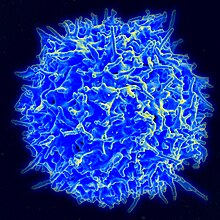| Chronic mucocutaneous candidiasis | |
|---|---|
| Other names | CMC |
 | |
| Specialty | Infectious diseases, dermatology |
| Symptoms | Skin ulcer |
| Types | CANDF1,2,3,4,5,6,7,8 and 9j |
| Diagnostic method | Thyroid function test, Liver function test |
| Treatment | Systemic antifungal therapy |
Chronic mucocutaneous candidiasis is an immune disorder of T cells. It is characterized by chronic infections with Candida that are limited to mucosal surfaces, skin, and nails. It can also be associated with other types of infections, such as human papilloma virus. An association with chromosome 2 has been identified.
Types
| Type | OMIM | Gene | Locus |
|---|---|---|---|
| CANDF1 | 114580 | - | 2p |
| CANDF2 | 212050 | CARD9 | 9q34.3 |
| CANDF3 | 607644 | - | 11 |
| CANDF4 | 613108 | CLEC7A | 12p13.2-p12.3 |
| CANDF5 | 613953 | IL17RA | 22q11 |
| CANDF6 | 613956 | IL17F | 6p12 |
| CANDF7 | 614162 | STAT1 | 2q32 |
| CANDF8 | 615527 | TRAF3IP2 | 6q21 |
| CANDF9 | 616445 | IL17RC | 3q25 |
Signs and symptoms
The signs and symptoms of this condition are thickened skin, skin ulcer, dyspareunia, endocardium abnormality, vision problems, hepatitis, seizures, bloody urine, and meningitis.
Associated diseases or conditions
There are a number of disorders associated with chronic mucocutaneous candidiasis including endocrine dysfunctions, vitiligo, malabsorption syndromes, neoplasms, and others. In most patients, chronic mucocutaneous candidiasis is correlated to abnormalities in cell-mediated immunity (T-lymphocyte mediated response). The T-lymphocytes fail to produce the necessary cytokines that are required for immunity against Candida. Current effective treatments include anti-fungal drugs and, for long-term remissions, restoration of cellular immunity.
Patients with autosomal-dominant mucocutaneous candidiasis may be at risk for epidermoid esophageal cancer due to the nitrosamine compounds produced by chronic candida infections.
Cause
Chronic mucocutaneous candidiasis can be inherited either autosomal dominant or autosomal recessive. There are 9 types of this condition with the first CANDF1 being located at 2p22.3-p21 (cytogenetically).
Mechanism
The mechanism the human immune system has is normally to fight an infection (like Candida). Initially, Th17 cells are made by the immune system, which in turn produces interleukin-17 (IL-17). This induces inflammation and white blood cells confront infection.
Chronic mucocutaneous candidiasis mutations affect IL-17 by inhibiting its pathway. This in turn affects the human immune system's ability to fight infection, in total there are 9 possible types of this condition.
Diagnosis
Chronic mucocutaneous candidiasis can be diagnosed in an affected individual via the following methods/tests:
- Thyroid function test
- Liver function test
- Cellular immunity test
- Skin biopsy
- Genetic testing
Treatment

Management for an individual with chronic mucocutaneous candidiasis consists of the following (relapse occurs once treatment is ceased, in many cases):
- Systemic anti-fungal therapy (e.g., Fluconazole)
- Transfer factor
- Combination therapy
- Screening (annually)
See also
Notes
Indicates 9 references to specific, numbered pages in the Online Mendelian Inheritance in Man database.
References
- ^ RESERVED, INSERM US14 -- ALL RIGHTS. "Orphanet: Chronic mucocutaneous candidiasis". www.orpha.net. Archived from the original on 2017-07-14. Retrieved 2017-06-09.
{{cite web}}: CS1 maint: numeric names: authors list (link) - ^ "Candidiasis familial chronic mucocutaneous, autosomal recessive | Genetic and Rare Diseases Information Center (GARD) – an NCATS Program". rarediseases.info.nih.gov. Archived from the original on 2018-04-17. Retrieved 2017-06-09.
- ^ "Familial chronic mucocutaneous candidiasis - Conditions - GTR - NCBI". www.ncbi.nlm.nih.gov. Archived from the original on 2018-05-26. Retrieved 2017-06-09.
- ^ "Chronic Mucocutaneous Candidiasis: Background, Pathophysiology, Epidemiology". Medscape. 3 May 2017. Archived from the original on 10 June 2017. Retrieved 8 June 2017.
- James, William D.; Berger, Timothy G. (2006). Andrews' Diseases of the Skin: clinical Dermatology. Saunders Elsevier. ISBN 978-0-7216-2921-6.
- Kirkpatrick, Charles H. (February 2001). "Chronic mucocutaneous candidiasis". The Pediatric Infectious Disease Journal. 20 (2): 197–206. doi:10.1097/00006454-200102000-00017. PMID 11224843.
- Rosa DD, Pasqualotto AC, Denning DW. Chronic mucocutaneous candidiasis and oesophageal cancer. Med Mycol. 2008 Feb;46(1):85-91. doi: 10.1080/13693780701616023. PMID 17852718.
- "OMIM Entry - % 114580 - CANDIDIASIS, FAMILIAL, 1; CANDF1". omim.org. Archived from the original on 31 March 2021. Retrieved 9 June 2017.
- ^ Reference, Genetics Home. "familial candidiasis". Genetics Home Reference. Archived from the original on 2017-06-27. Retrieved 2017-06-09.
- Smeekens, Sanne P; van de Veerdonk, Frank L; Kullberg, Bart Jan; Netea, Mihai G (2013). "Genetic susceptibility to Candida infections". EMBO Molecular Medicine. 5 (6): 805–813. doi:10.1002/emmm.201201678. ISSN 1757-4676. PMC 3779444. PMID 23629947.
- Teng, Joyce; Marqueling, Ann L.; Benjamin, Latanya (2016-12-15). Therapy in Pediatric Dermatology: Management of Pediatric Skin Disease. Springer. p. 265. ISBN 9783319436302. Archived from the original on 2023-01-12. Retrieved 2020-12-09.
Further reading
- Kauffman, Carol A.; Pappas, Peter G.; Sobel, Jack D.; Dismukes, William E. (2011). Essentials of Clinical Mycology. Springer Science & Business Media. ISBN 9781441966407. Retrieved 9 June 2017.
- Ostler, H. Bruce (2004). Diseases of the Eye and Skin: A Color Atlas. Lippincott Williams & Wilkins. ISBN 9780781749992. Retrieved 9 June 2017.
External links
| Classification | D |
|---|---|
| External resources |
| Fungal infection and mesomycetozoea | |||||||||||||||||||||||
|---|---|---|---|---|---|---|---|---|---|---|---|---|---|---|---|---|---|---|---|---|---|---|---|
| Superficial and cutaneous (dermatomycosis): Tinea = skin; Piedra (exothrix/ endothrix) = hair |
| ||||||||||||||||||||||
| Subcutaneous, systemic, and opportunistic |
| ||||||||||||||||||||||
| Mesomycetozoea | |||||||||||||||||||||||
| Ungrouped | |||||||||||||||||||||||

